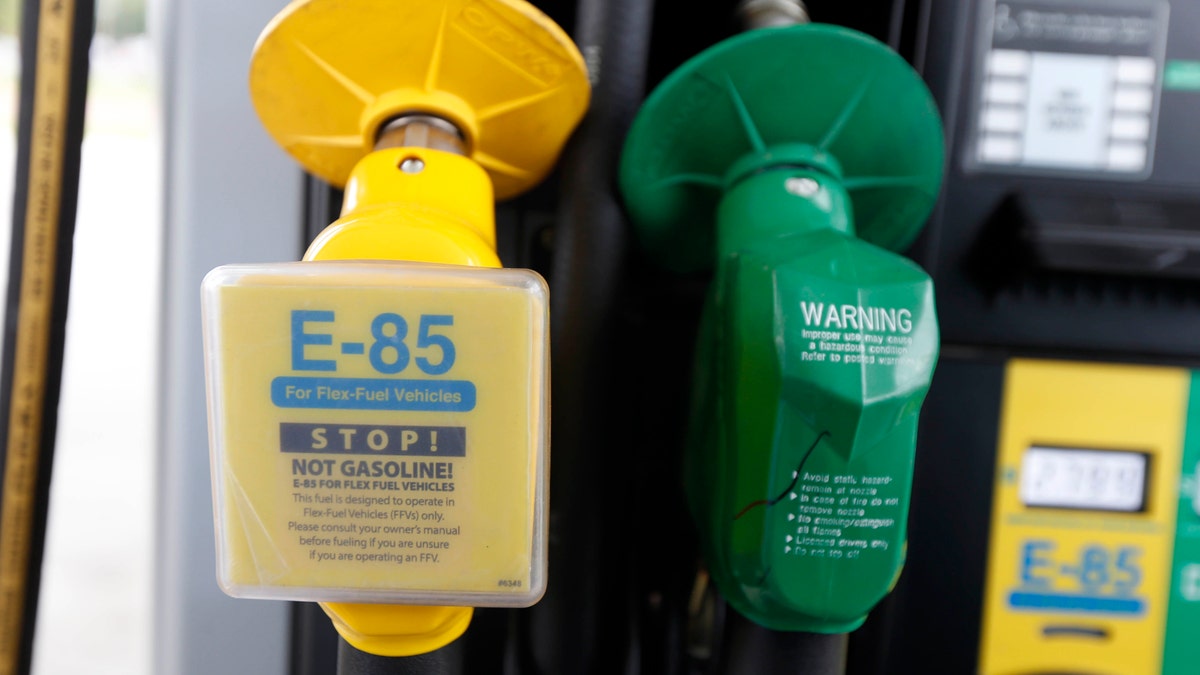
Aug. 9, 2014 –FILE photo of nozzles for biofuel E-85, and traditional gasoline at a gas station in Batesville, Miss. (AP)
On November 30, as the Paris international climate conference was getting underway, the U.S. Environmental Protection Agency (EPA) announced a long-overdue update of Renewable Fuel Standard (RFS) requirements. Originally established in 2005 and then greatly expanded by the Energy Independence and Security Act (EISA) of 2007, the RFS mandates increasing use of ethanol, biodiesel and other biofuels in America's cars and trucks.
Two things were notable. For the first time, EPA set the overall mandate at levels significantly lower than targets Congress called for in 2007. Second, raising the hackles of the biofuel lobby, the Obama administration omitted the RFS from its official submission in Paris about actions the U.S. is taking to cut carbon emissions.
In other words, the EPA seems to realize that the nation's dream plan for green fuels was unrealistic, and the Obama administration is tacitly admitting that biofuels aren’t better than fossil fuels when it comes to greenhouse gases. In fact, they are worse.
Nonetheless, in announcing the new standards, the administration used the usual biofuel-boosting rhetoric, reaffirming the political tripod on which the RFS is propped. By "cutting carbon pollution, reducing our dependence on foreign oil and sparking rural economic development," the RFS has made the biofuel industry "an incredible American success story," as one EPA official put it.
Biofuels have no climate benefit when they're burned. Basic chemistry tells us that essentially the same amount of carbon gets emitted from tailpipes when using ethanol or biodiesel instead of regular gasoline and diesel.
Well, it's a sad state of affairs if what constitutes “success” depends on billions of dollars of direct and indirect public subsidies for a wobbly industry that in reality has but one leg to stand on, namely, the political power of certain agribusiness interests.
How did we get here? The years leading up to the passage of the RFS saw rising fuel prices, war in the Middle East and irrational fears that world oil supplies had peaked, setting the stage for political opportunism by biofuel lobbyists and certain environmentalists.
This alignment of interests sold Congress and the George W. Bush administration on the unreal vision that "Growing Energy," as one green group's manifesto put it, would benefit the climate and provide an economically viable alternative to oil.
Indeed, much of Big Green was so enthralled at the notion of teaming up with Big Ag to roll Big Oil that no one performed due diligence on the climate impact of biofuels. Instead, they promoted the simplistic but scientifically unsound notion that biofuels are automatically carbon neutral because crops grown to produce fuel recycle carbon from the air.
This assumption is now deeply embedded in the "carbon footprint" computer models used by EPA. It's also hard-coded into the Department of Energy model widely cited by biofuel lobbies to claim that the RFS cuts emissions. The same model is used by California for its so-called Low-Carbon Fuel Standard.
That assumption of carbon neutrality is deeply flawed. In fact, biofuels have no climate benefit when they're burned. Basic chemistry tells us that essentially the same amount of carbon gets emitted from tailpipes when using ethanol or biodiesel instead of regular gasoline and diesel.
The only way biofuels might have a greenhouse benefit is if crops used to make them take carbon from the atmosphere faster than it would otherwise be removed.
The problem computer models don’t recognize is that farmland is already recycling copious quantities of carbon. Cropland doesn't absorb more carbon when the harvest is used for fuel rather than food. After adding in the pollution from processing corn into ethanol, and then the deforestation triggered by a need to make up for grain lost to the food market, ethanol's emissions are far worse overall than those of gasoline.
The energy security rationale for biofuels is likewise based on faulty reasoning. Over the past decade, advanced technologies and new investments have caused a big jump in oil reserves domestically and around the world. The result is burgeoning oil production, lower prices for consumers, and the reality that heavily subsidized biofuels are not needed as a security blanket.
At the same time, rising vehicle efficiency and decreased driving have trimmed gasoline demand, which also helped depress pump prices. Lower fuel demand means there's no room to force more ethanol into gasoline without breaking through the "blend wall," the 10 percent limit above which ethanol starts to wreak havoc with older vehicles as well as lawn, garden and recreational equipment, boat engines and other gasoline-powered devices.
The blend wall is the main reason why EPA trimmed this year's total RFS requirement to 3.6 billion gallons less than the 2007 Congressional mandate.
So what we now have is a one-legged tripod. All that's left to prop up the policy is a narrow agribusiness interest of soaking consumers for more money.
That leg might look solid, especially as we witness the upcoming, bipartisan electoral ritual of bowing to the Iowa corn gods.
But an increasing number of lawmakers from both parties are starting to realize that the Renewable Fuel Standard was a mistake. It might be ripe for reform if not outright repeal in 2017 -- which would undoubtedly be the best outcome for the planet.
